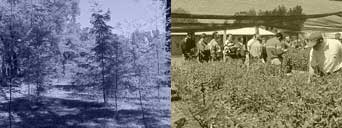Forestry Genomics:
improving the
performance of
Eucalyptus globulus

Presently, several countries are
developing genomic projects
to improve the performance of
lumber plantations. Today in
Chile, forestry genomics is just
beginning on this path. Even
though there are successful
genetic improvement programs
in Chile that, through traditional
crosses based on phenotypic
observations, have increased
biomass production. Indeed,
genomics is more complex than
a simple observation, given
that it involves aspects like
gene identification and
sequencing, knowing when and
why these are activated, and
how they function when
interacting with other genes,
among other aspects.
University researchers and
lumber companies are working
together to select Eucalyptus
globulus clones (the most
appreciated species after pinus
radiata for its fiber quality) and
to develop biotechnological
tools that can predict lowtemperature
resistance. This
project, with researchers from
the Faculties of Forestry
Science and Natural and
Oceanographic Sciences, has
obtained funding from the
Agricultural Innovation Fund
(FIA) and Innova Bío Bío for
the development of
Biotechnology Projects in the
Bio Bio region.
The researchers will investigate
three lines of research: the
first, already mentioned,
consists in developing
predictive tools related with
resistance to cold in
Eucalyptus globules clones,
studying genomic aspects of
the samples such as proteins
and the implicated metabolic
pathways, and to identify finally
those genes that will improve
this species for their later
application to improve
Eucalyptus globulus plantations
in Chile, and especially in colder
areas.
A second line of research is a
Fondef project that will study the
characteristics of lignin (an
undesirable compound produced
in the pulping process) using the
infrared spectroscopy technique.
Additionally, this technique
permits the prediction of treepulping
performance and fiber
quality.
The development of this tool will
save on work because it permits
the selection of the best
eucalyptus clones whose genetic
characteristics can then be
studied. Indeed, this will produce
a significant quantitative and
qualitative jump: once the genetic
sequences are obtained, crossings
can be planned with greater
certainty and, in a near future,
pulping performance in the
plantations could increase up to
2%.
Reducing the consumption of the
involved chemical reactants in
lignin produces both economic
and environmental benefits (since
the extraction process produces
this contamination). In this
sense, there are two beneficial
alternatives: either land becomes
available for more plantations or
the actual use of plantations is
optimized.
The third line of action includes
resistance to the pathogens
through the chemical, enzyme
and molecular analysis of their
genetic properties since there is
a wide spectrum of pathogenic
agents that affect Eucalyptus
globulus plantations in Chile. |

